International Harvester
 | |
| Industry | Agricultural, Automotive |
|---|---|
| Fate | Renamed as Navistar International Corporation |
| Predecessor |
McCormick Harvesting Machine Company Deering Harvester Company Warder, Bushnell, and Glessner etc. |
| Successor | Navistar International |
| Founded | 1902 |
| Founder | Cyrus Hall McCormick |
| Headquarters | Lisle, Illinois |
Area served | Worldwide |
Key people | Cyrus Hall McCormick, J.P. Morgan |
| Products | Farm Machinery, Vocational Trucks, Household Appliances, Passenger Vehicles, Construction and Industrial Equipment |
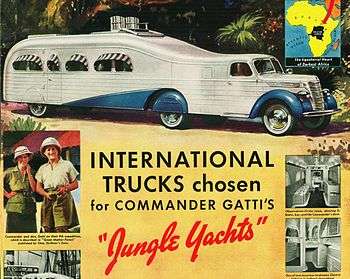
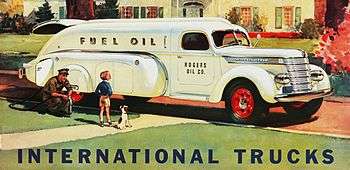
The International Harvester Company (abbreviated first IHC and later IH) was a United States manufacturer of agricultural machinery, construction equipment, trucks, and household and commercial products. Its reorganized successor, after spin-off of several of those businesses, is Navistar International. In 1902, J.P. Morgan merged the McCormick Harvesting Machine Company and Deering Harvester Company, along with three smaller agricultural equipment firms, to form International Harvester. In 1985, International Harvester sold off most of its agricultural division to Tenneco, Inc., which merged it into its subsidiary J.I. Case under the Case IH brand. Following the terms of IH's agreement with Tenneco, the remainder of International Harvester (primarily heavy trucks) became Navistar International Corporation in 1986.
History
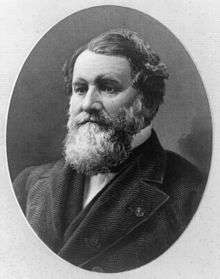
Founding of the company
The roots of International Harvester run to the 1830s, when Cyrus Hall McCormick, an inventor from Virginia, finalized his version of a horse-drawn reaper, which he field-demonstrated throughout 1831, and for which he received a patent in 1834. Together with his brother Leander J. McCormick (1819–1900), McCormick moved to Chicago in 1847 and started the McCormick Harvesting Machine Company. The McCormick reaper sold well, partially as a result of savvy and innovative business practices. Their products came onto the market just as the development of railroads offered wide distribution to distant market areas. He developed marketing and sales techniques, developing a vast network of trained salesmen able to demonstrate operation of the machines in the field.
McCormick died in 1885, with his company passing to his son, Cyrus McCormick, Jr., whose antipathy and incompetence toward organized labor sparked the Haymarket affair, the origin of May Day as a labor holiday. In 1902, the McCormick Harvesting Machine Company and Deering Harvester Company, along with three smaller agricultural equipment firms (Milwaukee Harvesting Machine Co., Plano Manufacturing Co., and Warder, Bushnell, and Glessner—manufacturers of Champion brand) merged to create the International Harvester Company. Banker J.P. Morgan provided the financing.[2] In 1919, the Parlin and Orendorff factory in Canton, Illinois, was a leader in the plow manufacturing industry. International Harvester purchased the factory, calling it the Canton Works; it continued production for many decades.
The golden years of IH
In 1926, IH's Farmall Works began production in a new plant in Rock Island, Illinois, built solely to produce the new Farmall tractor. By 1930, the 100,000th Farmall was produced. IH next set their sights on introducing a true 'general-purpose' tractor designed to satisfy the needs of the average US family farmer. The resulting 'letter' series of Raymond Loewy-designed Farmall tractors in 1939 proved a huge success, and IH enjoyed a sales lead in tractors and related equipment that continued through much of the 1940s and 1950s, despite stiff competition from Ford, John Deere, and other tractor manufacturers.
IH ranked 33rd among United States corporations in the value of World War II production contracts.[3] In 1946 IH acquired a defense plant in Louisville, Kentucky, which was enlarged, expanded, and re-equipped for production of the Farmall A, B, and the new 340 tractors. Then in 1948, IH acquired the Metropolitan Body Company of Bridgeport, Connecticut.[4] This was the manufacturing facility for the bodies of the commercially successful Metro line of forward control vans and trucks from 1938 until roughly 1964.
In 1974, the five-millionth IHC tractor was produced at the Rock Island Farmall plant.
Throughout the 1960s and 1970s, despite good sales, IH's profit margins remained slim. The continual addition of unrelated business lines created a somewhat unwieldy corporate organization, and the company found it difficult to focus on a primary business, be it agricultural equipment, construction equipment, or truck production. An overly conservative management, combined with a rigid policy of in-house promotions, tended to stifle new management strategies, as well as technical innovation. Products with increasingly ancient technology continued in production despite their marginal addition to sales. Worse, IH not only faced a threat of strong competition in each of its main businesses, but also had to contend with increased production costs, primarily due to labor and government-imposed environmental and safety regulations.[5]
Downfall
In 1979, IH named a new CEO, who was determined to improve profit margins and drastically cut ballooning costs. Unprofitable model lines were terminated, and factory production curtailed. By the end of the year, IH profits were at their highest in 10 years, but cash reserves were still too low. Union members became increasingly irate over production cutbacks and other cost-cutting measures. In the spring and summer of 1979, IH began short-term planning for a strike that seemed inevitable. Then on November 1, IH announced figures showing that president and chairman Archie McCardell received a $1.8 million (in 1979 values) bonus. McCardell sought overtime, work rule, and other changes from the United Auto Workers, which led to a strike on November 2, 1979.[6] Soon after, the economy turned unfavorable, and IH faced a financial crisis. The strike lasted about six months. When it ended, IH had lost almost $600 million (in 1979 value; over $2 billion today).[7]
By 1981, the company's finances were at their lowest point ever. The strike, accompanied by the economy and internal corporate problems, had placed IH in a hole that had only a slim way out.[8] Things only got worse until 1984, when the bitter end came. International Harvester, following long negotiations, agreed to sell selected assets of its agricultural products division to Tenneco, Inc. on November 26, 1984. Tenneco had a subsidiary, J.I. Case, that manufactured tractors, but lacked the full line of farm implements that IH produced (combines, cotton pickers, tillage equipment, etc.)
Following the merger, tractor production at Harvester's Rock Island, Illinois, Farmall Works ceased in May 1985. Production of the new Case IH tractors moved to the J.I. Case Tractor Works in Racine, Wisconsin. Production of IH Axial-Flow combines continued at the East Moline, Illinois, combine factory. Harvester's Memphis Works in Memphis, Tennessee, was closed and cotton picker production was moved. The truck and engine divisions remained, and in 1986, Harvester changed the corporate name to Navistar International Corporation (Harvester had sold the International Harvester name and the IH symbol to Tenneco Inc. as part of the sale of its agricultural products division). Navistar International Corporation continues to manufacture medium- and heavy-duty trucks, school buses, and engines under the International brand name.[7]
Divisions and products
Agriculture
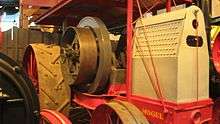
The International Harvester Agricultural Division was second to the Truck Division, but was the best-known IH subsidiary. When IH sold the agricultural products division to Tenneco in 1985, the International Harvester name and "IH" logo, went with it.
One of the early products (besides the harvesting equipment that McCormick and Deering had been making prior to the merger) from the newly created International Harvester Company was the Traction Truck: a truck frame manufactured by Morton Traction Truck Company (later bought by IHC) with an IHC engine installed.
From 1902, when IH was formed, to the early 1920s, the McCormick and Deering dealerships kept their original brands unique, with Mogul tractors sold at McCormick dealers, and Titan tractors at Deering dealerships, due to the still-present competitiveness of the former rivals.
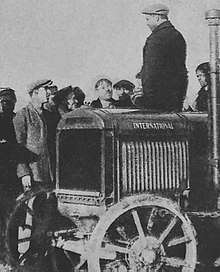
The early tractors
IH produced a range of large gasoline-powered farm tractors under the Mogul and Titan brands. Sold by McCormick dealers, the Type C Mogul was little more than a stationary engine on a tractor chassis, fitted with friction drive (one speed forward, one reverse).[9] Between 1911 and 1914, 862 Moguls were built.[9] These tractors had varied success, but the trend going into the mid-1910s was "small" and "cheap".
The first important tractors from IH were the model 10-20 and 15-30. Introduced in 1915, the tractors (which were smaller than their predecessors) were primarily used as traction engines to pull plows and for belt work on threshing machines. The 10-20 and 15-30 both had separate, but similar, Mogul and Titan versions.
Around this time, IHC purchased a number of smaller companies to incorporate their products into the IH dealer arsenal. Parlin & Orendorff - P&O Plow and Chattanooga Plow were purchased in 1919. Other brand names they incorporated include Keystone, D.M. Osborne, Kemp, Meadows, Sterling, Weber, Plano, and Champion.
In 1924 IH, introduced the Farmall tractor, a smaller general-purpose tractor, to fend off competition from the Ford Motor Company's Fordson tractors. The Farmall was a leader in the emerging row-crop tractor category.
Following the introduction of the Farmall, IH introduced several similar-looking "F Series" models that offered improvements over the original design (the original model became known as the "Regular").
In 1932, IH produced their first diesel engine, in the McCormick-Deering TD-40 crawler. This engine started on gasoline, then switched over to diesel fuel. Diesel engines of this era were difficult to start in cold weather, and using gasoline allowed the engine to start easily and thoroughly warm up before making the switch to diesel in all weather conditions. In 1935, this engine was put in the International Harvester WD-40, becoming the first diesel tractor on wheels in North America[10] (the world's first diesel tractor was the German Benz-Sendling BS 6, introduced in 1922).
The letter and standard series
For model year 1939, industrial designer Raymond Loewy was hired to design a new line of tractors. The sleek look, combined with other new features, created what is known as the Farmall "letter series" (A, B, BN, C, H, and M) and the McCormick-Deering "standard series" (W-4, W-6, and W-9). Model year 1941 had the introduction of the model MD, the first rowcrop diesel-powered tractor; over a decade later, IH's largest competitor, John Deere, introduced a diesel option on their rowcrop tractors. The letter series tractors were updated to the "super" series in 1953 (with the exception of the A, which had become a "super" in 1947, and the B and BN, which were discontinued in 1948) and received several improvements. Many of these tractors (especially the largest: the H, M, and W models) are still in operation on farms today. Especially desirable are the diesel-powered MD, WD-6, and WD-9. These tractors carried forward the unique gasoline start diesel concept of the WD-40.
The letter and standard series of tractors was produced until 1954, and was a defining product in IH history.
In 1947, the smallest tractor in the Farmall line was introduced, the Cub. With a 60 cu. in. four-cylinder engine and a 69-inch wheelbase, the Cub was aimed at small farms such as truck farms, horse farms, and other small acreages that had previously continued to rely on horse-drawn equipment. Like the various John Deere L/LA/LI models, one of the "mechanization-resistant" markets it hoped to penetrate was the small, poor, one-mule family farms of the rural American Deep South, but the Cub also sold to owners of larger farms who required a second tractor. Production of the Cub commenced at the newly acquired Farmall Works-Louisville plant (formerly the wartime Curtiss-Wright Aircraft factory in Louisville, Kentucky) which was expanded, remodeled, and re-equipped. Selling for $545.00 in 1947, the Cub proved extremely popular, and the original design continued in production without significant alteration until 1979.
For 1955 in IH tractors, the numbered "hundred-series" was offered. Although given slightly different looks and few new features, they were still updates to the models introduced in 1939. The only new tractor in the 1955 lineup was the 300 Utility. In 1957, IH gave the tractor lineup another update by increasing power in some models, adding a new 230 Utility model, adding new white paint to the grill and sides, and giving new number designations. This improved sales at the time, but IH's inability to change and update was already showing.[11]
60 Series recall
In July 1958, IH launched a major campaign to introduce a new line of tractors to revitalize slumping sales. At the Hinsdale, Illinois, Testing Farm, IH entertained over 12,000 dealers from over 25 countries. IH showed off their new "60" series of tractors: including the big, first-of-its-kind, six-cylinder 460 and 560 tractors. The joy of the new line of tractors was short lived, though. One of the first events that eventually led to the downfall of IH presented itself in 1959. In June of that year, IH recalled the 460, 560, and 660 tractors: final drive components had failed. IH, which wanted to be the first big-power manufacturer, had failed dramatically by not upgrading the final drives on the new six-cylinder tractors. These final drives were essentially unchanged from 1939 and would fail rapidly under the stress of the more powerful 60-series engines. IH's competitors took advantage of the recall, and IH lost customers in the ensuing months,[11] with many customers moving to John Deere's New Generation of Power tractors introduced in 1960.
1960s
Throughout the 1960s, IH introduced new tractors and new sales techniques. As producing tractors was the lifeblood of the company, IH would have to remain competitive in this field. They both succeeded and failed at this goal, but farming was about to change, and IH and its competitors were in for a bumpy ride. In 1963, IH introduced the 73 hp (54 kW) 706 and 95 hp (71 kW) 806 tractors. In 1964, IH made its four-millionth tractor, an 806. In 1965, IH introduced its first 100 hp (75 kW) two-wheel-drive tractor, the 1206. Another option became available in 1965 for the 706, 806, and the new 1206: a factory-installed cab (made by Stopler Allen Co.). This cab is often called the "ice cream box" cab due to its shape. The cab could be equipped with a fan and heater. By 1967, over 100,000 models 706, 806, and 1206 were built. The 276 International Harvester was also built at this time becoming popular for smaller farms with tighter lanes and fields due to mobility and weight making the 276 a popular seller boosting International Harvester's slim profits.
In 1967 was the introduction of the "56" series tractors as replacements for the successful and popular "06" series. These new "56s" were bigger and more powerful than the "06s". The new models included the 65 hp (48 kW) 656, 76 hp (57 kW) 756, the 101 hp (75 kW) 856, and the 116 hp (87 kW) 1256. The "ice cream box" cab was still an option. In 1969 IH introduced the 1456 Turbo at 131 hp (98 kW). Also that year, the 91 hp (68 kW) 826 was introduced with the option of gearshift or hydrostatic transmissions. The "ice cream box" cab was dropped and replaced with the new "custom" cab made by Exel Industries, which could be equipped with factory air-conditioning, heat, and an AM radio. Another milestone for IH was the 1970 introduction of the 1026 Hydro which was basically a hydrostatic version of the 1256, at that time the most powerful hydrostatic transmission tractor made in the US at 114 hp (85 kW).
1970s
In 1971, IH introduced the 66 series line. The new models included the 85 hp (63 kW) 766, the 101 hp (75 kW) 966, the 125 hp (93 kW) 1066 turbo, the 145 hp (108 kW) 1466 Turbo, and the 145 hp (108 kW) 1468 V-8. The 130 hp (97 kW) 4166 4WD was also introduced. The 966 and 1066 were available with Hydro or gearshift transmissions and the choice of two-post roll over protection structures (ROPs) or two different cabs, the "custom" and the "deluxe". Both could be equipped with air conditioning, heat, and AM-FM radios.
In 1972, the 666 replaced the long-running 656, the 150 hp (110 kW) 1568 V-8 replaced the 1468, and the 160 hp (120 kW) 1566 and the 163 hp (122 kW) 4366 4WD were introduced. Also later that year, four-post ROPs replaced two-post; the "custom" cab was dropped and the "deluxe" cab was now painted red instead of white. Due to horsepower confusions, the 966 and 1066 Hydro models were restriped; the Hydro 100 and the 666 Hydro became the Hydro 70. On February 1, 1974, at 9:00 am, the five-millionth tractor came off the assembly line at the Farmall Plant in Illinois. IH was the first tractor manufacturer to accomplish this.[11] Also in 1973, IH officially dropped the "Farmall" name from its tractor. This ended an era that began with the first Farmall "Regular" back in 1924.
The 230 hp (170 kW) 4568 V-8 4WD was introduced in 1975. In 1976, the entire tractor line got a new paint job and decal pattern. No longer were the side panels all white with chrome and black decals: they were now all red with a black-striped sticker. This was done to clear inventory for the forthcoming Pro Ag Line.
In September 1976, IH released their 86 series Pro Ag Line. The models included the 80 hp (60 kW) 786, the 90 hp (67 kW) 886, the 101 hp (75 kW) 986, the 104 hp (78 kW) 186 Hydro, the 135 hp (101 kW) 1086, the 146 hp (109 kW) 1486 and the 161 hp (120 kW) 1586. These new tractors had a new cab dubbed the Control Center that came standard with air conditioning, heat, and several radio-CB options. The driver sat well ahead of the rear axle and the fuel tank was mounted behind the cab over the rear axle. This increased balance and ride. Also in 1976, the 62 hp (46 kW) 686 along with the "86" series four-wheel-drives were introduced, including the 4186, 4586, and 4786.
In 1977, International Harvester introduced the first Axial-Flow rotary combine. This machine, produced at East Moline, Illinois, was the first generation of over 30 years of Axial-Flow combines.
In 1979, IH introduced two all-new tractors: the 3388 and 3588, known as the 2+2 4WD line. These tractors were the result of taking two 1086 rear ends and hooking them together with a transfer case. A year later, the 3788 was introduced. Although these tractors performed well in the field, they never sold well.
1980s
As the 1980s began, IH faced a stable economy, yet an unknown fate. In September 1981, IH announced at a dealership meeting the new "50 Series" of tractors, which included the 136 hp (101 kW) 5088, the 162 hp (121 kW) 5288 and the 187 hp (139 kW) 5488. IH also released the "30 series", which included the 81 hp (60 kW) 3088, the 90 hp (67 kW) 3288, the 112 hp (84 kW) 3488Hydro, and the 113 hp (84 kW) 3688. These new tractors proved once again that IH was innovative. Designed and styled by IH industrial designer Gregg Montgomery (Montgomery Design International), the new stylish design of the 50 and 30 series changed the look of tractors from that time forward. IH spent over $29 million to develop this new series, and the result was the last great lineup of tractors from International Harvester.
Many technology-related innovations were used in the new series. A computer monitoring system (Sentry) was developed, and IH became the first manufacturer to add a computer to a farm tractor. Other innovations included a "Z" shift pattern, an 18-speed synchronized transmission, a forward air-flow cooling system which sucked air from above the hood and blew it out the front grille, "Power Priority" three-pump hydraulic system, color-coded hydraulic lines and controls, and a new rear-hitch system. The 50 Series had an unprecedented three-year or 2,500-hour engine and drive-train warranty, which later became an industry standard. Although no new sales records were set, IH sold a respectable number of these tractors during their short production time. IH also released the "60 series 2+2s" and planned on making the "Super 70 series" 2+2s, but only a handful of these exist today. On May 14, 1985, the last IH tractor rolled off the factory line, a 5488 FWA.
In the late 1970s, IH entered a deal with Spain's Enasa to build diesel engines there as Internacional de Motores. After a downturn in the market coupled to problems with Spain's entry into the European Economic Community threatened the profitability of this project, International Harvester withdrew in 1982.[12] In return for being allowed to escape all conditions of the joint venture, IH lost their up-front investment in the engine plant and ended up selling British truck manufacturer Seddon Atkinson (which had belonged to IH since 1974) to Enasa in 1983.
Brand names of the agriculture division

IH over the years used a number of brand names to market their tractor and harvesting products:
- International (1902–1985)
- Titan (1910–1924)
- Mogul (1911–1924)
- McCormick–Deering (1922–1947)
- McCormick (1947–1958)
- Farmall (1924–1973)
- Fairway (1924–1938)
- Electrall (1954–1956)
Other agricultural products
Along with the prominent tractor division, IH also sold several different types of farm-related equipment, such as balers, cultivators, combines (self-propelled and pull behind), combine heads, corn shellers, cotton pickers, manure spreaders, hay rakes, crop dusters, disk harrows, elevators, feed grinders, hammer mills, hay conditioners, milking machines, planters, mills, discs, plows, and miscellaneous equipment.[13]
Also produced were twine, stationary engines, loaders, and wagons.[13]
Electrall
The Electrall system was introduced in 1954; it was a short-lived attempt to market electrically operated farm equipment and accessories. The system, co-developed with General Electric, consisted of a 208V three-phase alternating-current generator connected with electric cables to the device to be powered. The generator could even power a household. A 10 kW Electrall generator was an option on the Farmall 400 tractor,[14] and a 12.5 kW PTO-driven version was made. The possible applications of Electrall power were many, but few made it to market. IH marketing materials showed a haybaler being Electrall powered. One of the more novel applications of the Electrall was a device to electrocute insects in the field at night (basically like a modern-day bug zapper, but on a larger scale).[15]
Vehicles
Light duty trucks
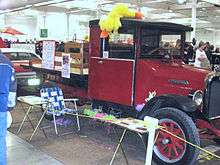
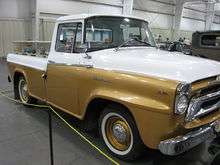
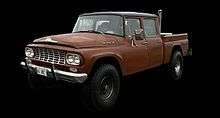
IH is often remembered as a maker of relatively successful and innovative "light" lines of vehicles, competing directly against the Big Three. The most common were pickup trucks. IH made light trucks from 1907 to 1975, beginning with the Model A Auto Wagon (sometimes called the "Auto Buggy").[16] Production commenced in February 1907 at IH's McCormick Works in Chicago, although production was moved to Akron, Ohio, in October that year.[16] Powered by a horizontally opposed, air-cooled twin around 15 hp (11 kW), it was a right-hand-drive model popular in rural areas for high ground clearance on the poor roads typical of the era. It featured a rear seat convertible to a carrier bed.[17] The Auto Wagon was renamed the Motor Truck in 1910, and was a forerunner to the successful modern pickup truck. They were called IHC until 1914, when the 'International' name was first applied.[16] The final light line truck was made on May 5, 1975.
IH also had early success with the Auto Buggy, which started production in February 1907. In the mid-1940s, International released their K and KB series trucks, which were more simplistic than other trucks released in that era. This was followed by the L Series in 1949, which was replaced by the R Series in 1952, followed by the S line in 1955. In 1957, to celebrate IH's golden anniversary as a truck manufacturer, this was replaced by the new A line. 'A' stands for anniversary. With light modifications to its appearance, but more serious changes under the shell (and a number of new names), this design continued in production until replaced by the 1100D in late 1969, which looked very similar to the Scout.[18]
Corresponding with the truck "letter lines" was the Metro line of step (delivery) vans. Starting in 1938 and manufactured through 1975, the Metro series was produced and updated with each iteration of IH's truck lines. Also, special-use variants were sold, such as the Metro Coach (a bus version with windows and passenger seats) and Metro front-end section and chassis for full commercial customization. Additional variants were based on the medium-duty engine and chassis lines.[19]
One of the company's light-duty vehicles was the Travelall, which was similar in concept to the Chevrolet Suburban. The Travelette was a crew cab, available in two- or four-wheel drive. A three-door version was available starting in 1957, and a four-door version was available starting in 1961. The 1961 Travelette four-door (crewcab) was the first six-passenger, four-door truck of its time. The Scout, first introduced in 1961,[16] is a small, two-door SUV, similar to a Jeep. In 1972, the Scout became the Scout II, and in 1974, Dana 44 axles, power steering, and power disc brakes became standard. After the Light Line pickups and Travelall were discontinued in 1975, the Scout Traveler and Terra became available, both with a longer wheelbase than a standard Scout II.
IH abandoned sales of passenger vehicles in 1980 to concentrate on commercial trucks and school buses. Today, the pickups, Travelalls, and Scouts are minor cult orphaned vehicles. All were also available as rugged four-wheel drive off-road vehicles.
The Scout and Light Truck parts business was sold to Scout/Light Line Distributors, Inc. in 1991.
Medium/heavy duty
IH was an early manufacturer of medium- and heavy-duty trucks. Although based upon truck chassis, IH also became the leading manufacturer of the chassis portion of body-on-chassis conventional (type C) school buses. In 1962, IH offered the International Harvester Loadstar which became the premier medium-duty truck. In 1978, IH offered the International Harvester S-Series, which replaced the Loadstar in 1979.
With the truck and engine divisions remaining following the 1985 sale of the agricultural division, International Harvester Company changed their corporate name to Navistar International in 1986. Today, Navistar International's subsidiary, International Truck and Engine Corporation, manufactures and markets trucks and engines under the International brand name.
The Ford Power Stroke engine was manufactured by International Truck and Engine Corporation in Indianapolis, Ind., for use in Ford heavy-duty trucks, vans, and SUVs.
Military
IH manufactured light, medium, and heavy vehicles for military use. Examples include a Metro van sold to the Czechoslovakian Army in 1938, as M5 Tractors and 2.5-ton M-5H-6 trucks for the US Navy and Marines in 1942,[20] and around 3,500 2.5 ton M-5-6-318 cargo trucks provided mostly to Soviet Union and China.[21]
Motorhomes
In the 1970s, motorhomes were manufactured using IHC engines and bare chassis. Most of the bodies were constructed of fiberglass.
Overseas subsidiaries
Australia
Australian Army designs
International Harvester Australia, a subsidiary of the US manufacturer, had a long relationship with the Australian Army with the US-designed AS series trucks in the early 1950s. The AS164 2X4 used as a tractor unit[22] and the 2X4 AS161 used as a trayback troop transport[23]
The association between International Harvester Australia and the Australian Army developed and in conjunction with the Army Design Establishment of the Australian Commonwealth Department of Supply, designed and constructed a range of trucks for the Australian Army. With the body loosely based upon the design of cab 13 of the Canadian Military Pattern truck, the first prototype built in 1959 was the International Truck Cargo 2½ Ton General Service, Australian No.1 Mk1.[24] which was followed by the Mk2 prototype. A variant with a midmounted, 20,000-lb winch, resulted in the first production model,[25] the Mk3 entering service in 1963 – just in time for Australia's entry into the Vietnam War.
A five-ton 6X6 version was to follow with three major variants the Truck Cargo 5 Ton with winch F1[26] which replaced the Mk3 in Vietnam service.
The F2 a tipper version[27] that replaced the International Harvester AB160 "teaspoon Tipper"[28] in both Vietnam and Borneo theatres of operations.
The F5 wrecker[29] with a lack of 4X4 2 1/2 ton trucks available because of the Vietnam War, the Mk3 was supplemented with further 4X4 production with the updated Mk4 version[30] which shared the cab with the 6X6 variants Production of The Australian No.1. range of trucks were produced until 1973. The Mk3, Mk4, F1, F2 and F5 saw service until the late 1980s.[31][32]
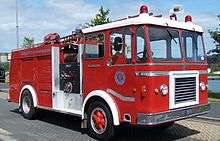
ACCO

The Australian-designed and -built International Australian A-line Cab Over (AACO)was first produced in the late 1960s and later in 1972 the Australian C-line Cab Over (ACCO) . The ACCO is a cab over engine type truck and has been offered in 4x2, 4x4, 6x2, 6x4, 8x4, and 10x4 configurations. Engines used have been Cummins, Caterpillar, Detroit Diesel, Perkins, Neuss or GMC with Road-Ranger or Allison transmissions and Rockwell differentials. The ACCO range were built to order, serving private operators, fire departments, military services, and municipal departments across Australia and New Zealand. The ACCO became the most popular product of International Harvester in Australia. The ACCO continues to be manufactured to date, under the ownership of Iveco.[33]
Brazilian subsidiary
International Harvester Máquinas S.A. was established with Brazilian government support as part of a project to develop a vehicle industry there. Their first product was the International S-184 heavy truck.[34] In 1966 Chrysler purchased International's Brazilian plant.[35]
U.S. Truck series since 1960
Loadstar (1962–1979)
.jpg)
The first-generation Loadstar was primarily used for local delivery, including school buses and fire engines. It was also used extensively in the agricultural and construction industries. It was widely recognizable by its grey grill and "butterfly" hood, but some late models had one-piece tilting hoods. Most had a medium-duty 4x2 chassis, but some 6x4 heavy-duty models were built. This series was replaced by the S-Series in the 1970s.
Fleetstar (1962-1977)
The heavy-duty Fleetstar was a short-hood conventional replacing the heaviest-duty R-Series conventionals. Designed primarily for vocational use, the Fleetstar was configured with either single or tandem rear axles. As with the Loadstar, during its production, it was fitted with a "butterfly" hood; a tilting fiberglass hood later became an option.
The Fleetstar was replaced by the S-Series after 1977.
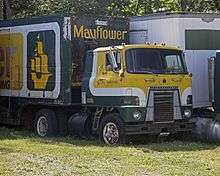
CO-4000 (1965-68)
The CO-4000 was the first COE highway tractor designed entirely by International Harvester, replacing a generation of tilt-cab tractors derived from a Diamond T design. In what would become a design feature in its later COE tractors, the CO-4000 was distinguished by a large trapezoidal grille.
The CO-4000 was replaced by the Transtar-series cabovers in 1968.
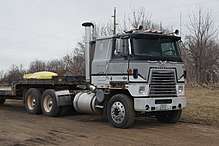
Transtar/Transtar II (1968-1981)
During 1968, the CO-4000 cab underwent a major redesign in an effort to accommodate larger-displacement diesel engines. Sharing the trapezoidal grille of the CO-4000, the Transtar added a black-trim exterior band to the grille, becoming a feature shared with the later Cargostar. In 1974,the Transtar II was introduced. Though externally identical, the Transtar II featured larger-displacement engines.
Cargostar (1970-1986)
The tilt-cab Cargostar began life in 1963, as the CO-Loadstar. A low-cab COE, the vehicle was designated as its own product line for 1970 with a widened cab. Similar in configuration to the Ford C-Series, the Cargostar was a medium-duty truck with both gasoline and diesel engines.
The Cargostar was replaced by the International 400/500/700/900, produced by Nissan Diesel (UD) from 1986-1991.
Transtar conventional (1971-1984)
The Transtar conventional was introduced in 1971. A semitractor designed for regional and over-the-road shipping, the Transtar was available in two hood lengths, depending on engine specifications.
In 1985, the long-hood Transtar was rebranded the International 9370, marking the start of the International 9000 series.
.jpg)
Paystar (1973-2016)
In 1973, International Harvester developed an all-new severe-service conventional to replace its R 210/230 (introduced in 1960) and M-Series (introduced in 1964) trucks. Using the cab of the Transtar conventional, the Paystar 5000 was given flat steel fenders and a butterfly hood.
Alongside its standard configuration, the Paystar was produced with a set-back front axle configuration, with various rear axle configurations. Following the development of the Transtar, the Paystar became the 5000i in 2000, and again the Paystar in 2008.
In 2016, the International HX-Series replaced the Paystar (with which it shares its cab).
S-series (1977–2001)
The S-Series is a range of medium-duty conventional trucks that was introduced in 1977, consolidating the Loadstar and Fleetstar lines into a single product range.[36] To do so, the S-Series was produced as a straight truck, semitractor, and as a cowled bus chassis. Along with medium-duty vehicles, the S-Series was also offered in severe-service configurations (slotted below the Paystar). In addition to single and tandem rear axles (named the F-Series)[37], the model line was offered with a driven front axle (providing four/six wheel drive).
Produced in two generations, the S-Series would outlive International Harvester by over 15 years. In 2001, medium-duty production ended, replaced by the 4000-series (today the Durastar) with severe-service trucks ending production in 2003 (eventually replaced by the Workstar).[38] In 2004, the S-Series ended as Navistar produced its final conventional-style bus chassis of its generation.
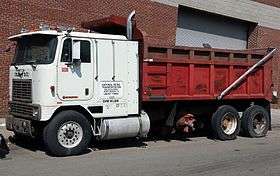
9000-series COEs (1981-present)
In 1981, International Harvester replaced the Transtar II with an all-new tilt-cab highway tractor. Making use of smaller-displacement diesel engines, the CO9670 XL introduced a wider cab, larger doors (shared with the Transtar 4000), and larger windshield with a nearly identical grille to the Transtar II. In 1988, a set-back front axle version was introduced, becoming the first cabover sold in North America with a completely flat floor.
After 1998, the 9000-series cabovers ended production in the United States, with Navistar exporting the tooling; as of 2017, the model line remains in production outside of North America.
Home
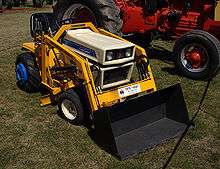
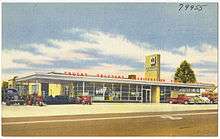
Lawn and garden
IH branched out into the home lawn and garden business in the 1960s with its line of Cub Cadet equipment, which included riding and walk-behind lawn mowers and snow blowers. Also produced were compost shredders, rotary tillers, Cadet garden tractors, and power washers.
The Cub Cadet line was sold to MTD Products in 1981.[39]
Home appliances
Although best known for farm equipment, IH produced home appliances for farmers and nonfarmers alike. This included refrigeration equipment such as refrigerators, air conditioners, and freezers. IH had a refrigeration division of its own, as did other vehicle manufacturers of the time: Ford had Philco, Chrysler had Airtemp, General Motors had Frigidaire, Nash-Kelvinator Corporation (and then American Motors) had Kelvinator, Studebaker had the Franklin Appliance Company, and Crosley had Crosley.
The IH appliance division had originally been developed to manufacture commercial-grade items to farmers, most of whom had just received electricity by way of the many electrification projects in the U.S. before and after World War II. Among the offerings were milk coolers and walk-in freezers for produce and meat. Later on, IH courted the farmer's wife with kitchen refrigerators available in the latest designer styles. The IH spokeswoman for these products was Irma Harding, a factory trademark. These products were introduced in 1947 and sold for less than 10 years. The refrigeration division was sold to Whirlpool Corporation in 1955. Since the time of production was short, IH appliances are rare today.[13][40]
On the show Friend's, the refrigerator in Monica's apartment is a circa 1950 International Harvester.
Other products
Weapons
In early 1951, the United States Army through the Springfield Armory contracted International Harvester to produce M1 rifles, and from 1953 to 1956 produced 337,623 rifles in total, according to the Army Ordnance Department.
HT-341
In 1959, International Harvester created a jet turbine-powered tractor called the International HT-341. It was donated to the Smithsonian Institution in 1967.
See also
References
- Crismon, Frederick W. (2002), International Trucks (2nd ed.), Minneapolis: Victory WW2 Publishing, ISBN 0-9700567-2-9
- ↑ Popular Mechanics. Books.google.com. Retrieved 2016-03-09.
- ↑ "International Harvester". Antique Farming web site. Archived from the original on March 19, 2016. Retrieved November 20, 2016.
- ↑ Peck, Merton J. & Scherer, Frederic M. The Weapons Acquisition Process: An Economic Analysis (1962) Harvard Business School p.619
- ↑ "1948 International Harvester Annual Report". 1949. Retrieved 12 August 2012.
- ↑ "Navistar International: Information from". Answers.com. Retrieved 2012-09-29.
- ↑ Loomis, Carol J. "The Strike That Rained on Archie McCardell's Parade." Fortune. May 19, 1980; Friedman, Raymond A. "Interaction Norms as Carriers of Organizational Culture: A Study of Labor Negotiations at International Harvester". Journal of Contemporary Ethnography. 18:1 (April 1989); Zimmerman, Frederick M. The Turnaround Experience: Real-World Lessons in Revitalizing Corporations. New York: McGraw–Hill, 1991. ISBN 0-07-072899-2
- 1 2 Leffingwell, Randy (2005). Farmall Eight Decades of Innovation. St. Paul, Minnesota: MBI Publishing. ISBN 0-7603-2136-1.
- ↑ Williams, Winston. "Long Strike Is Called Key McCardell Error." New York Times. May 4, 1982; "Workers End Six-Month Walkout." Associated Press. April 21, 1980
- 1 2 Placard at WDM.
- ↑ "A History of John Deere Model R Tractors". Retrieved 2007-11-02.
- 1 2 3 Updike, Kenneth (2000). International Harvester Tractors 1955–1985. Osceola, Wisconsin: MBI Publishing. ISBN 0-7603-0682-6.
- ↑ Kennett, Pat (September 1982). "Intertruck: Spain". TRUCK. London, UK: FF Publishing Ltd: 27.
- 1 2 3 Wendel, Charles (2004). 150 Years of International Harvester. Lola, Wisconsin: Krause Publications. ISBN 0-87349-928-X.
- ↑ The mid-mount Electrall unit installs on the Super M-TA, Super W-6TA, 400, 450 and 560 tractors equipped with the I-PTO option.
- ↑ "Insect Electrocution". Ag and Food Newsletter. 2 (14): 711. 1954-07-07. Retrieved 2008-11-27.
- 1 2 3 4 "International Harvester History: Trucks". International Harvester. 1961.
- ↑ Placard at the Saskatchewan Western Development Museum, where the car was on display.
- ↑ "Smithson International Truck Museum: Truck Collection". Rimbey, Alberta, Canada: Pas-ka-poo Historical Park. Retrieved 2011-08-26.
- ↑ Carlsom, B Mitchell. "The Timeless Metro". Red Power. Sept/Oct, Nov/Dec, Jan/Feb. 27 & 28: 34–36.
- ↑ "2 1/2-ton, 6x6 Trucks of WW II P2". Olive-drab.com. Retrieved 2016-03-09.
- ↑ "Engines of the Red Army in WW2 – International M-5-6x4-318 with BM-13-16 Katiusha rocket launcher". O5m6.de. Retrieved 2016-03-09.
- ↑ "The Army Inter Chapter – AR164". REMLR. Retrieved 2012-09-29.
- ↑ "The Army Inter Chapter – AS161". REMLR. Retrieved 2012-09-29.
- ↑ "The Army Inter – No.1, Mk.1". REMLR. Retrieved 2012-09-29.
- ↑ "The Army Inter – No.1, Mk.3". REMLR. Retrieved 2012-09-29.
- ↑ "The Army Inter – No.1, Mk.5, F1". REMLR. Retrieved 2012-09-29.
- ↑ "The Army Inter – No.1, Mk.5, F2". REMLR. Retrieved 2012-09-29.
- ↑ "The Army InterChapter – AB160 Teaspoon Tipper". REMLR. Retrieved 2012-09-29.
- ↑ "The Army Inter – No.1, Mk.5, F5". REMLR. Retrieved 2012-09-29.
- ↑ "The Army Inter – No.1, Mk.4". REMLR. Retrieved 2012-09-29.
- ↑ "Defence Materiel Organisation - On Target August 2006". Defence.gov.au. Retrieved 2012-09-29.
- ↑ "Australian Government, Department of Defence". Defence.gov.au. 2012-01-20. Retrieved 2012-09-29.
- ↑ "ACCO turns 40". Iveco Australia. Archived from the original on 2014-05-13.
- ↑ Shapiro, Helen (Winter 1991). "Determinants of Firm Entry into the Brazilian Automobile Manufacturing Industry, 1956–1968". The Business History Review. 65 (4, The Automobile Industry): 879. doi:10.2307/3117267.
- ↑ Shapiro, p. 935
- ↑ Crismon, p. 485
- ↑ Crismon, p. 495
- ↑ Crismon, p. 492
- ↑ "Farmall Cub • View topic – Bought a 182 Cub Cadet". Farmallcub.com. Retrieved 2012-09-29.
- ↑ "Wisconsin Historical Society Frequently Asked Questions". Wisconsinhistory.org. Retrieved 2012-09-29.
External links
| Wikimedia Commons has media related to International Harvester vehicles. |